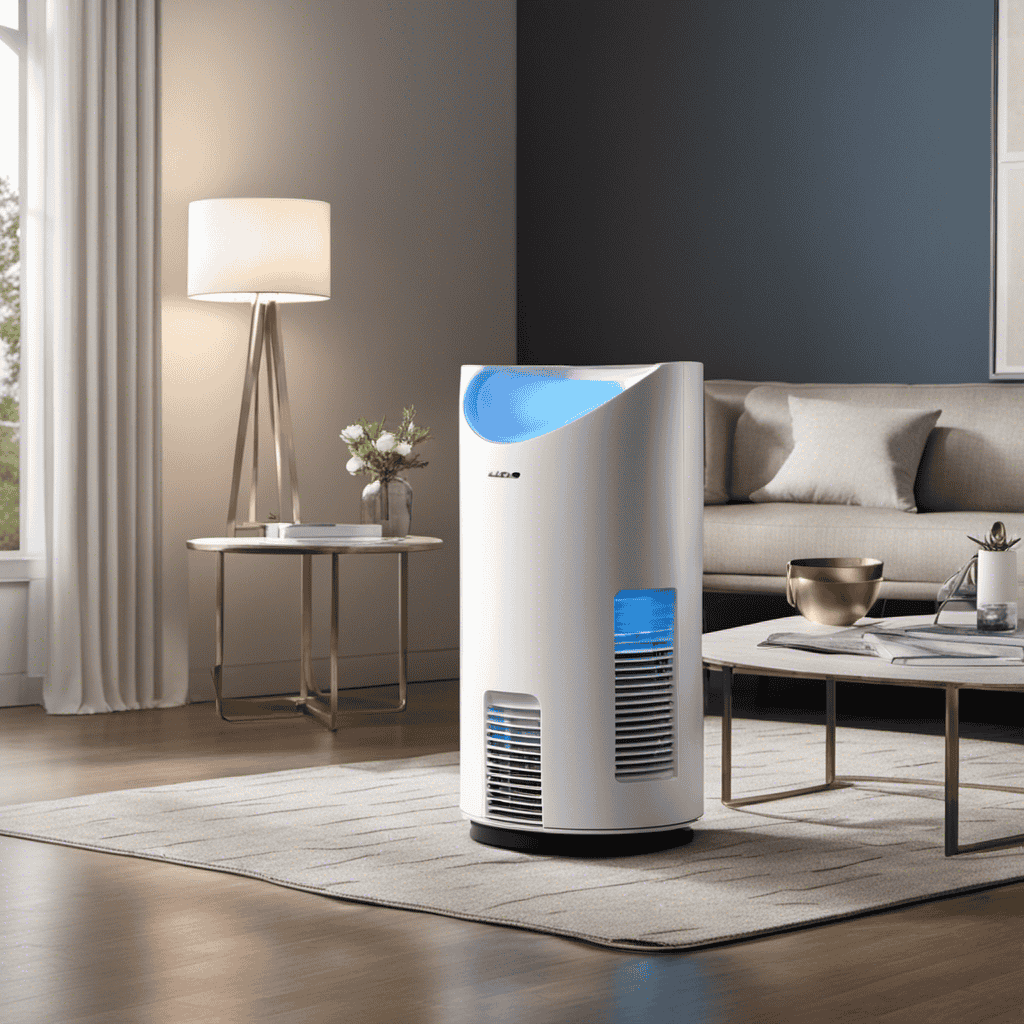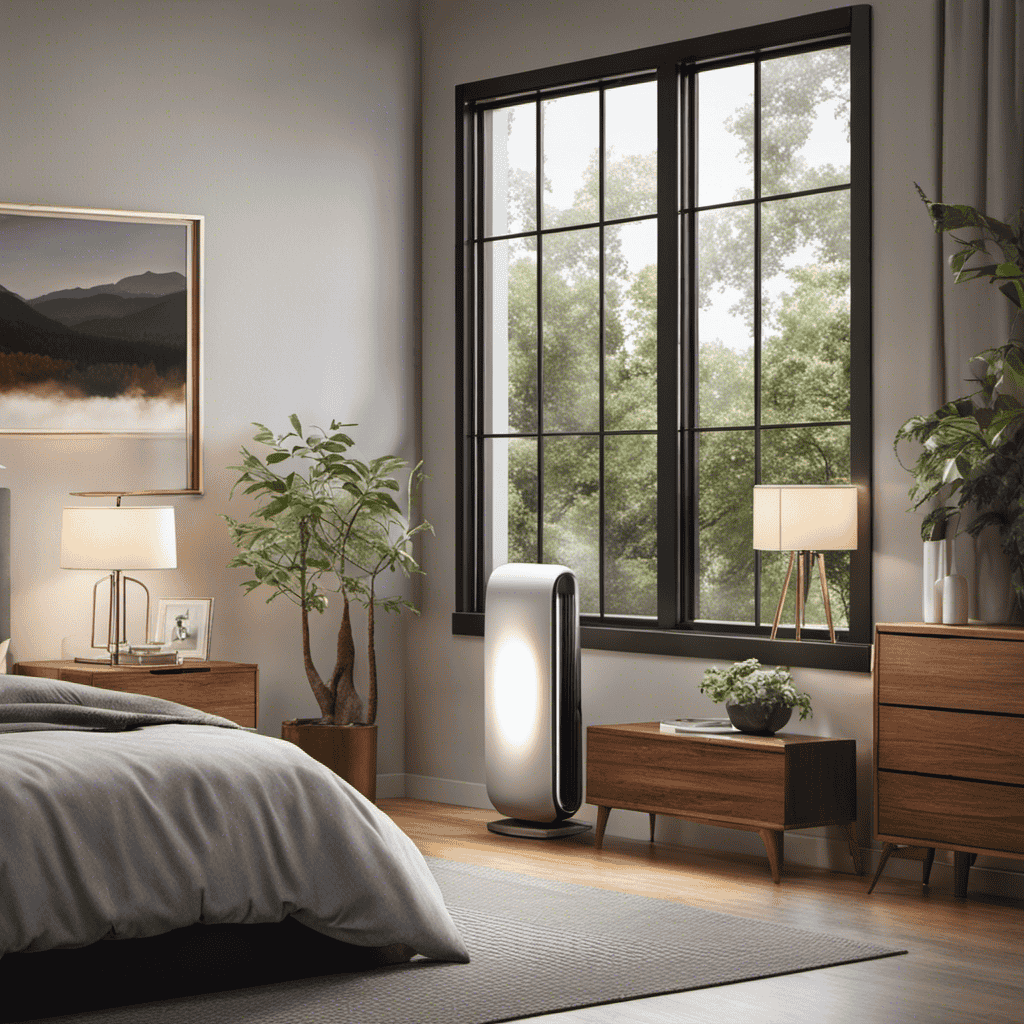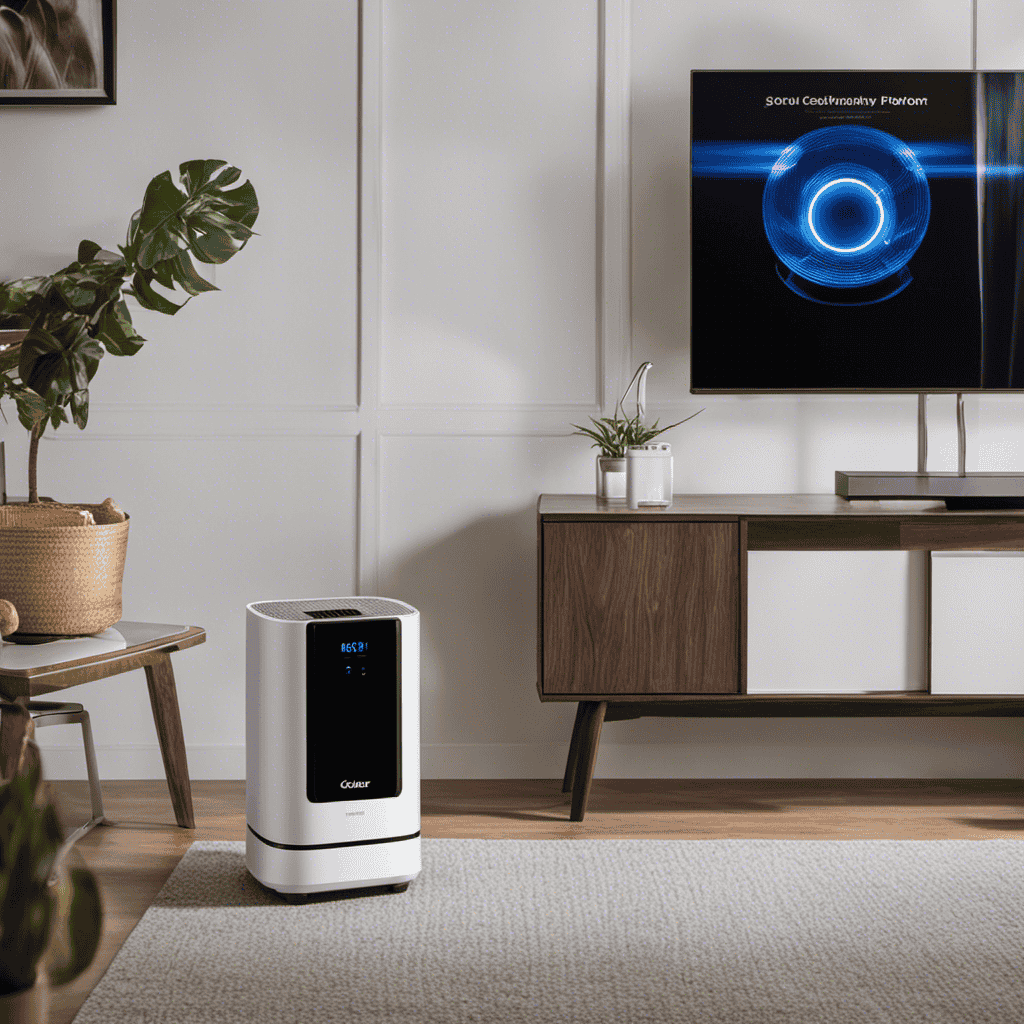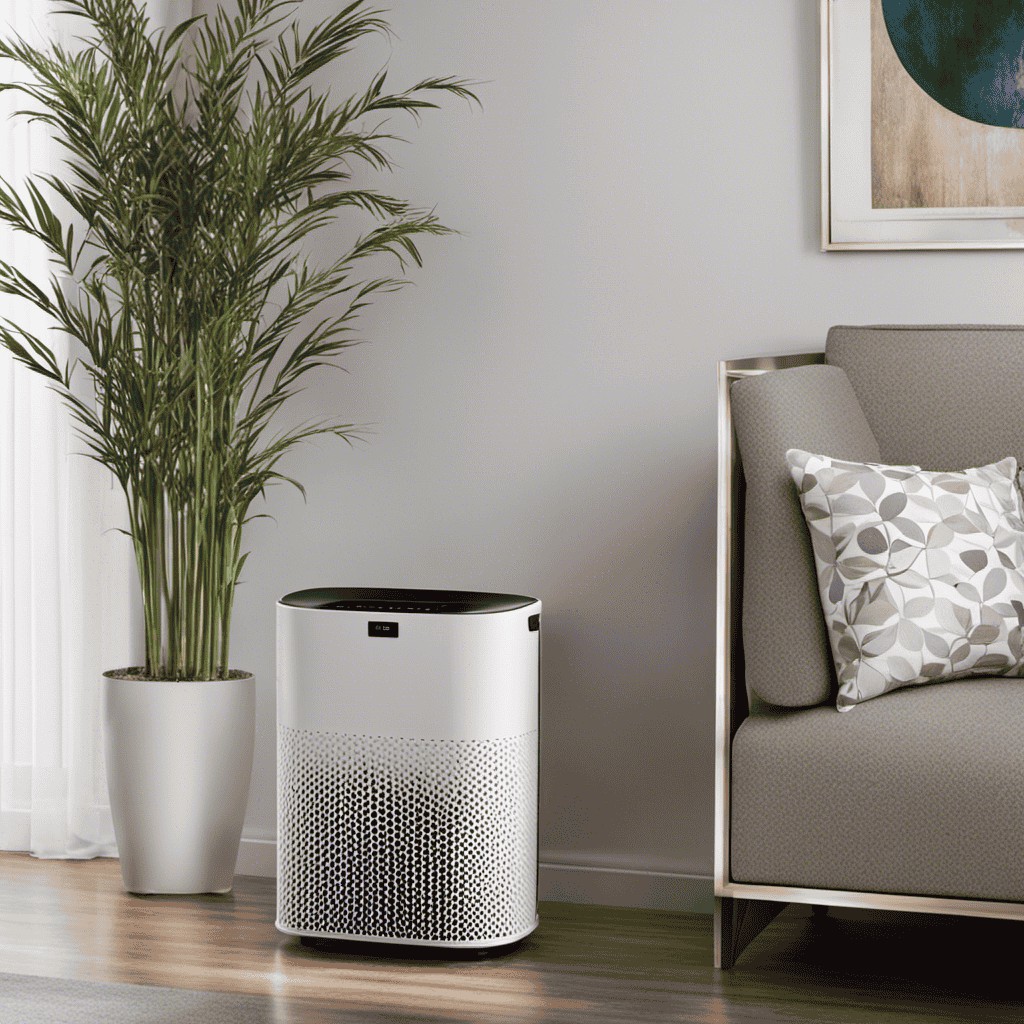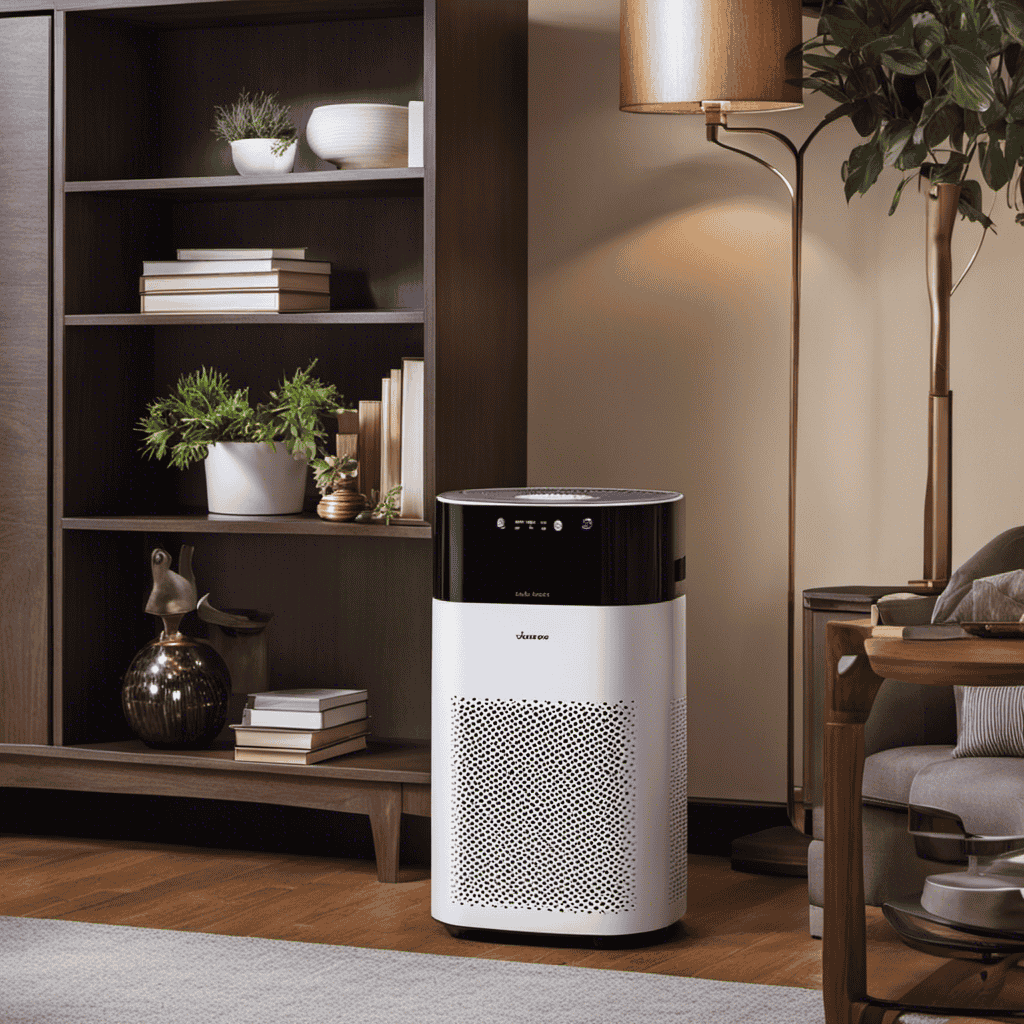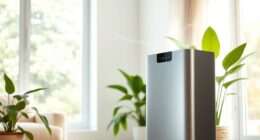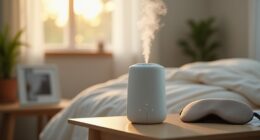As the adage goes, ‘knowledge is power.’ This is especially true when selecting an air purifier, where knowing the distinction between a HEPA filter and an electrostatic air purifier can be a game-changer.
In this article, I will delve into the technical details of these two purification mechanisms, exploring their filtration efficiency, airborne particle capture, maintenance and cleaning requirements, as well as cost, longevity, and environmental impact.
So, let’s dive in and equip ourselves with the knowledge needed to make an informed decision.
Key Takeaways
- HEPA filters offer higher filtration efficiency, capturing up to 99.97% of particles as small as 0.3 microns, while electrostatic air purifiers may not be as efficient in capturing smaller pollutants.
- HEPA filters require regular replacement, while electrostatic air purifiers need occasional cleaning.
- HEPA filters can remove common allergens, dust, pet dander, and pollen, while electrostatic air purifiers are effective against larger particles but may not capture smaller pollutants.
- HEPA filters do not produce harmful byproducts or ozone, while electrostatic air purifiers may produce ozone as a byproduct.
Purification Mechanism
If you’re looking to understand the purification mechanism, a HEPA filter works by trapping particles in a dense mesh, while an electrostatic air purifier uses an electric charge to attract and collect particles. Both air purifier technologies are effective in improving indoor air quality, but they work in slightly different ways.
A HEPA filter is made up of a dense mesh of fibers that traps particles as air passes through it. The filter captures particles as small as 0.3 microns, including dust, pollen, pet dander, and mold spores. The trapped particles remain on the filter until it is replaced or cleaned.
On the other hand, an electrostatic air purifier creates an electric charge that attracts particles in the air. Once attracted, the particles stick to oppositely charged plates within the purifier. These plates can be easily removed and cleaned, allowing the purifier to continue collecting particles.
In comparison, a HEPA filter provides a physical barrier that captures particles, while an electrostatic air purifier uses an electric charge to attract and collect particles. Both technologies are effective, but they have different maintenance requirements and considerations.
Filtration Efficiency
When it comes to air purification, the choice between a HEPA filter and an electrostatic air purifier can have a significant impact on the overall efficiency of the system.
Both options have their pros and cons, but understanding their differences is crucial in determining which one is more efficient.
In this discussion, we will delve into the technical aspects of HEPA and electrostatic filters, comparing their filtration capabilities, maintenance requirements, and potential drawbacks.
HEPA Vs Electrostatic
To determine the difference between a HEPA filter and an electrostatic air purifier, you should understand how each one operates and the pros and cons of using them.
HEPA filters are highly effective in removing up to 99.97% of airborne particles, including dust, pollen, mold spores, and pet dander. They work by forcing air through a dense mesh of fibers, trapping pollutants in the filter.
On the other hand, electrostatic air purifiers use an electric charge to attract and trap particles. While they can be effective in removing larger particles, they may not be as efficient in capturing smaller pollutants.
Here are the key differences between HEPA filters and electrostatic air purifiers:
- HEPA filters offer higher filtration efficiency.
- Electrostatic air purifiers may produce ozone as a byproduct.
- HEPA filters require regular replacement.
- Electrostatic air purifiers may require cleaning of the collection plates.
- HEPA filters are generally more expensive than electrostatic air purifiers.
Understanding these differences can help you make an informed decision when it comes to improving your indoor air quality and reducing exposure to indoor pollutants.
Which Is More Efficient
To determine which option is more efficient, you should consider the specific needs of your indoor air quality and the effectiveness of each method in removing pollutants. Both HEPA filters and electrostatic air purifiers have their advantages and disadvantages when it comes to air quality improvement and health benefits.
Here is a comparison table of the two methods:
| HEPA Filter | Electrostatic Air Purifier |
|---|---|
| Captures 99.97% of particles as small as 0.3 microns | Attracts and traps particles through an electrostatic charge |
| Requires regular filter replacement | No filter replacement required, but needs occasional cleaning |
| Can remove common allergens, dust, pet dander, and pollen | Effective against larger particles, but may not capture smaller pollutants such as gases and odors |
Pros and Cons
One should weigh the pros and cons of both options before making a decision.
Here are the pros of a HEPA filter:
- Highly efficient in capturing airborne particles, including pollen, pet dander, and dust mites.
- Removes up to 99.97% of particles as small as 0.3 microns in size.
- Provides cleaner and healthier air for individuals with allergies or respiratory conditions.
- Requires minimal maintenance, with filter replacements needed every 6 to 12 months.
- Does not produce harmful byproducts or ozone.
On the other hand, there are cons associated with electrostatic air purifiers:
- Less effective in capturing smaller particles compared to HEPA filters.
- May produce ozone as a byproduct, which can be harmful to individuals with respiratory issues.
- Requires regular cleaning to maintain efficiency.
- Can create a visible residue on surfaces due to the charged particles.
- May not be suitable for individuals with allergies or sensitivities to dust and other airborne particles.
Considering these factors, it is important to carefully evaluate the pros and cons of each option before deciding on an air purifier.
Now, let’s delve into the next section about airborne particle capture.
Airborne Particle Capture
There’s a significant difference in how airborne particles are captured between a HEPA filter and an electrostatic air purifier.
A HEPA (High-Efficiency Particulate Air) filter is a mechanical air filter that uses a dense mat of fibers to trap particles as air passes through. The airflow capacity of a HEPA filter is determined by its size and design, with larger filters typically having higher capacity.
HEPA filters are highly effective at capturing particles as small as 0.3 microns, including allergens, dust mites, pollen, and pet dander.
On the other hand, an electrostatic air purifier uses an electric charge to attract and trap particles. It works by creating an ionized field that charges particles, causing them to stick to oppositely charged plates or collecting plates.
While electrostatic air purifiers can effectively capture larger particles, they are less efficient at capturing smaller particles compared to HEPA filters.
In terms of health benefits, HEPA filters are recommended for individuals with allergies, asthma, or respiratory conditions, as they can help improve indoor air quality by removing harmful airborne particles.
Maintenance and Cleaning
The maintenance and cleaning process for a HEPA filter is relatively simple and involves regular replacement or vacuuming to remove accumulated particles. Here are some maintenance tips and common cleaning techniques for a HEPA filter:
-
Regular replacement: It’s recommended to replace the HEPA filter every 6 to 12 months, depending on the manufacturer’s instructions.
-
Vacuuming: Use a vacuum cleaner with a brush attachment to gently remove dust and debris from the surface of the filter.
-
Washing: Some HEPA filters are washable. Follow the manufacturer’s instructions to properly clean the filter using mild soap and water.
-
Air drying: After washing the filter, allow it to air dry completely before reinserting it into the air purifier.
-
Avoiding moisture: Keep the HEPA filter away from excessive moisture, as it can damage the filter’s effectiveness.
Following these maintenance tips and cleaning techniques will help ensure the optimal performance and longevity of your HEPA filter.
Cost and Longevity
To ensure your HEPA filter lasts longer and saves you money in the long run, it’s important to follow the recommended maintenance schedule and cleaning techniques.
When it comes to cost comparison, replacing a HEPA filter can be more expensive than an electrostatic air purifier. HEPA filters typically need to be replaced every 6 to 12 months, depending on the manufacturer’s guidelines and the air quality in your home.
On the other hand, electrostatic air purifiers use an electric charge to trap particles, so they don’t require filter replacement. Instead, they need regular cleaning to maintain their effectiveness.
While electrostatic air purifiers may have a higher upfront cost, they can save you money in the long term by eliminating the need for filter replacements.
Environmental Impact
When considering the environmental impact of a product, three key points to analyze are the carbon footprint, e-waste generation, and energy consumption.
A carbon footprint comparison allows us to measure the amount of greenhouse gas emissions produced throughout the product’s lifecycle.
E-waste generation analysis helps us understand the amount of electronic waste generated by the product and its proper disposal.
Energy consumption evaluation evaluates the energy consumption required for the product’s operation.
These factors play a crucial role in determining the overall sustainability and environmental friendliness of a product.
Carbon Footprint Comparison
One way to compare the carbon footprints of a HEPA filter and an electrostatic air purifier is by examining their energy consumption.
The energy consumption of a HEPA filter is generally lower compared to an electrostatic air purifier. This is because HEPA filters rely on a fan to draw air through the filter, which requires less energy compared to the ionization process used in electrostatic air purifiers.
Additionally, HEPA filters do not produce ozone, a greenhouse gas that contributes to climate change.
To further reduce the carbon footprint of air purifiers, there are sustainable alternatives available, such as using carbon offsetting programs to neutralize the emissions produced during manufacturing and use. These programs invest in projects that reduce greenhouse gas emissions, effectively balancing out the carbon footprint of the air purifiers.
E-Waste Generation Analysis
If you’re concerned about the impact of electronic waste, it’s important to consider the amount of e-waste generated from the use of various electronic devices.
E-waste, or electronic waste, refers to discarded electronic devices such as computers, smartphones, televisions, and appliances.
The rapid advancement of technology has led to a significant increase in the production of electronic devices, resulting in a growing concern for e-waste management and electronic waste disposal.
Proper e-waste management is crucial to minimize the environmental and health risks associated with the disposal of these devices.
Various strategies can be employed, such as recycling, refurbishing, and responsible disposal methods.
It is essential for individuals, businesses, and governments to work together to develop effective e-waste management systems and promote sustainable practices for electronic waste disposal.
Energy Consumption Evaluation
The energy consumption of electronic devices should be evaluated to determine their environmental impact. It is crucial to assess the energy efficiency and power consumption of these devices in order to make informed decisions about their use and to minimize their negative effects on the environment.
By evaluating the energy consumption of electronic devices, we can identify areas for improvement and develop strategies to reduce their environmental footprint. Some key factors to consider in this evaluation include:
-
Energy Star Certification: Look for devices that are certified by Energy Star, which indicates that they meet strict energy efficiency standards.
-
Standby Power: Assess the standby power consumption of devices, as this can contribute to significant energy waste over time.
-
Energy Management Features: Consider devices that have energy management features, such as power-saving modes and automatic shutdowns.
-
Energy Consumption Ratings: Compare the energy consumption ratings of different devices to choose the most efficient option.
-
Renewable Energy Compatibility: Investigate whether devices can be powered by renewable energy sources, such as solar or wind power.
Frequently Asked Questions
Can a HEPA Filter Remove Odors From the Air?
Yes, a HEPA filter can remove odors from the air. It is designed to capture particles as small as 0.3 microns, including smoke particles. For pet dander, both a HEPA filter and an electrostatic air purifier can be effective.
Are Electrostatic Air Purifiers Effective in Removing Allergens?
Yes, electrostatic air purifiers are effective in reducing allergens. While they may not be as efficient as HEPA filters in capturing dust particles, they still provide a significant level of filtration.
How Often Should I Replace the Filter in a HEPA Air Purifier?
I replace the filter in my HEPA air purifier every 6-12 months. Regular filter replacement ensures optimal performance and extends the lifespan of the purifier. Although it incurs some cost, the benefits outweigh the expense.
Can Electrostatic Air Purifiers Release Ozone Into the Air?
Yes, electrostatic air purifiers can release ozone into the air, which can be harmful to pets and humans. In contrast, HEPA filters effectively remove mold spores without emitting ozone.
Which Type of Air Purifier Is More Cost-Effective in the Long Run, a HEPA Filter or an Electrostatic Air Purifier?
In terms of energy consumption and maintenance costs, a HEPA filter is more cost-effective in the long run compared to an electrostatic air purifier. It requires less energy and has lower maintenance costs.
Conclusion
In conclusion, after examining the differences between a HEPA filter and an electrostatic air purifier, it is clear that both options have their advantages and disadvantages.
While HEPA filters provide a higher level of filtration efficiency and capture a wider range of airborne particles, electrostatic air purifiers offer easier maintenance and cleaning.
Furthermore, the cost and longevity of each option vary, with HEPA filters generally being more expensive but lasting longer.
Lastly, the environmental impact of both options should also be considered.
Overall, choosing between a HEPA filter and an electrostatic air purifier depends on individual needs and preferences, and conducting thorough research is crucial in making an informed decision.

